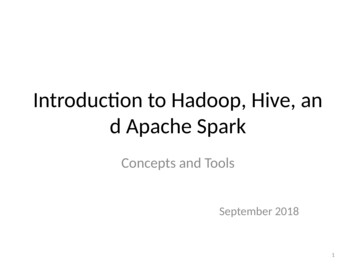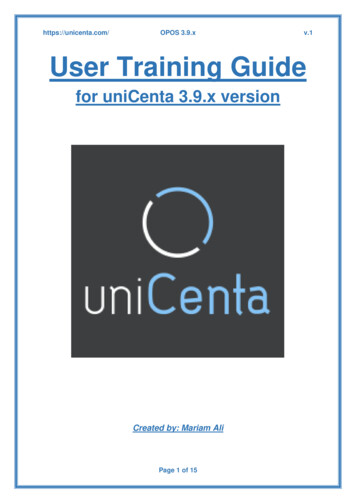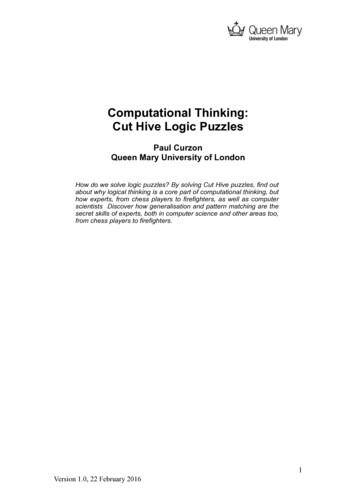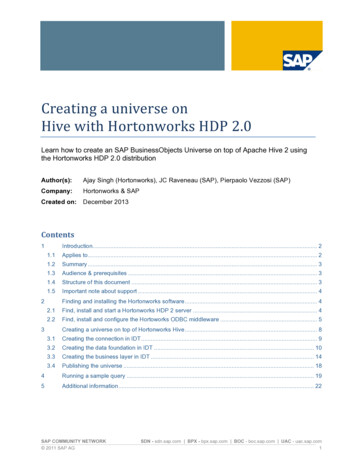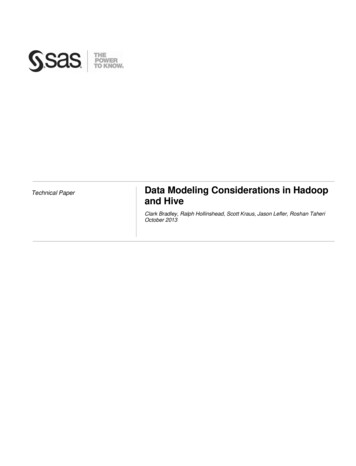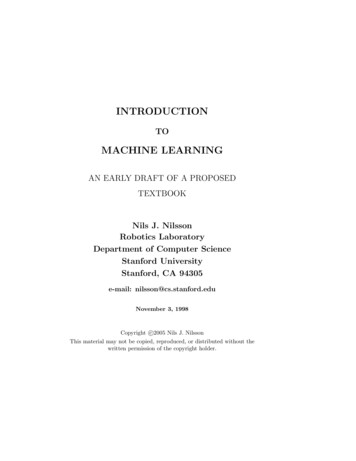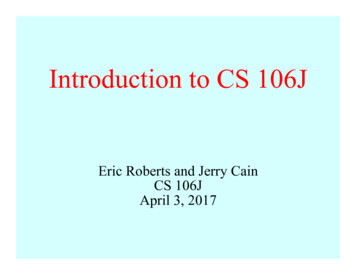
Transcription
Introduction To HiveHow to use Hive in Amazon EC2CS 341: Project in Mining Massive Data SetsHyung Jin(Evion) KimStanford UniversityReferences:Cloudera Tutorials,CS345a session slides,“Hadoop - The Definitive Guide”Roshan Sumbaly, LinkedIn
Todays Session Framework: Hadoop/Hive Computing Power: Amazon Web Service Demo LinkedIn’s frameworks & project ideas
Hadoop Collection of related sub projects fordistributed computing Open source Core, Avro, MapReduce, HDFS, Pig,HBase, ZooKeeper, Hive, Chukwa .
Hive Data warehousing tool on top of Hadoop Built at Facebook 3 Parts Metastore over Hadoop Libraries for (De)Serialization Query Engine(HQL)
AWS - Amazon WebService S3 - Data Storage EC2 - Computing Power Elastic Map Reduce
Step by step Prepare Security Keys Upload your input files to S3 Turn on elastic Map-Reduce job flow Log in to job flow HiveQL with custom mapper/reducer
0. Prepare Security Key AWS: Access Key / Private Key EC2: Key Pair - Key name and Key file(.pem)
1. Upload files to S3 Data stored in buckets(folders) This is your only permanent storage inAWS - save input, output here Use Firefox Add-on S3Fox Organizer(http://www.s3fox.net)
2. Turn ElasticMapReduce On
3. Connect to Job Flow(1) Using Amazon Elastic MapReduce Client ry.jspa?externalID 2264 Need Ruby installed on your computer
3.Connect to Job flow(2) - security Place credentials.json and .pem file in Amazon ElasticMapReduce Client folder, to avoid type things again and again le":"region":}" access-id "," private-key ","new-key","./new-key.pem","us-west-1",
3. Connect to Job Flow(3) list jobflows:elastic-mapreduce --list terminate job flow:elastic-mapreduce --terminate --jobflow id SSH to master:elastic-mapreduce --ssh id
4.HiveQL(1) SQL like language Hive ted Cloudera Hive eintroduction
4.HiveQL(2) SQL like Queries SHOW TABLES, DESCRIBE, DROPTABLE CREATE TABLE, ALTER TABLE SELECT, INSERT
4.HiveQL(3)- usage Create a schema around data: CREATEEXTERNAL TABLE Use like regular SQL: Hive automaticallychange SQL query to map/reduce Use with custom mapper/reducer: Anyexecutable program with stdin/stdout.
Example - problem Basic map reduce example - countfrequencies of each word!‘I’ - 3‘data’ - 2‘mining’ - 2‘awesome’ - 1.
Example - Input Input: 270 twitter tweetssample tweets.txtT 2009-06-08 21:49:37U http://twitter.com/evionW I think data mining is awesome!T 2009-06-08 21:49:37U http://twitter.com/hyungjinW I don’t think so. I don’t like data mining
Example - How? Create table from raw data filetable raw tweets Parse data file to match our format, and save to new tableparser.pytable tweets test parsed Run map/reducemappr.py, reducer.py Save result to new tabletable word count Find top 10 most frequent words from word count table.
Example-Create InputTableCreate Schema around raw data fileCREATE EXTERNAL TABLEraw tweets(line string)ROW FORMAT DELIMITEDLOCATION 's3://cs341/test-tweets';With this command, ‘\t’ will beseparator among columns, and ‘\n’will be separator among rows.
Example -CreateOutput TableCREATE EXTERNAL TABLE tweets parsed(time string, id string, tweet string)ROW FORMAT DELIMITEDLOCATION 's3://cs341/tweets parsed';CREATE EXTERNAL TABLE word count(word string, count int)ROW FORMAT DELIMITEDLOCATION 's3://cs341/word count';
Example TRANSFORMTRANSFORM - given python script will transform the input columnsLet’s parse original file to time , id , tweet ADD FILE parser.py;INSERT OVERWRITE TABLE tweets parsedSELECT TRANSFORM(line)USING 'python parser.py' AS (time, id, tweet)FROM raw tweets;Add whatever the script file youwant to use to hive first.Write out result of this selectto tweets parsed table
Example - Map/ReduceUse command MAP and REDUCE: Basically, same as TRANSFOMtweets parsed - map output - word countADD FILE mapper.py;ADD FILE reducer.py;FROM (FROM tweets parsedMAP tweets parsed.time, tweets parsed.id, tweets parsed.tweetUSING 'python mapper.py'AS word, countCLUSTER BY word) map outputINSERT OVERWRITE TABLE word countREDUCE map output.word, map output.countUSING 'python reducer.py'AS word, count;Use word as key
Example - Finding Top10 WordsUsing similar syntax as SQLSELECT word, count FROM word countORDER BY count DESC limit 10;
Example -JOINFinding pairs of words that have same count, and count bigger than 5SELECT wc1.word, wc2.word, wc2.countFROM word count wc1 JOIN word count wc2ON(wc1.count wc2.count)WHERE wc1.count 5 AND wc1.word wc2.word;
Frameworks fromLinkedIn Complete “data stack” from LinkedIn opensource @ http://sna-projects.com Any questions - rsumbaly@linkedin.com Introduce “Kafka” and “Azkaban” today.
Kafka(1) Distributed publish/ subscribe system Used at LinkedIn for tracking activity events http://sna-projects.com/kafka/
Kafka(2) Parsing data in files every time you want torun an algorithm is tedius What would be ideal? An iterator overyour data(hiding all the underneathsemantics) Kafka helps you publish data once(orcontinuously) to this system and thenconsume it as a “stream”.
Kafka(3) Example: Easy for implementing streamalgorithms on top of Twitter stream
Azkaban(1) A simple Hadoop workflow system Used at LinkedIn to generate wokflows forrecommendation features Last year many students wanted to iterateon their algorithms multiple times. Thisrequired them to build a chain of Hadoopjobs which they ran manually every day.
Azkaban(2) Example workflow Generate n-grams as a Java program- Feed n-grams to MR Algorithms X runon Hadoop- Fork n parallel MR jobs to feed this toAlgorithm X 1 to X n- Compare the results at the end http://sna-projects.com/azkaban
“Hadoop - The Definitive Guide” Roshan Sumbaly, LinkedIn CS 341: Project in Mining Massive Data Sets Hyung Jin(Evion) Kim Stanford University. Todays Session Framework: Hadoop/Hive Computing Power: Amazon Web Service Demo LinkedIn’s frameworks & project ideas. Hadoop Collection of related sub projects for distributed computing Open source Core, Avro, MapReduce,
